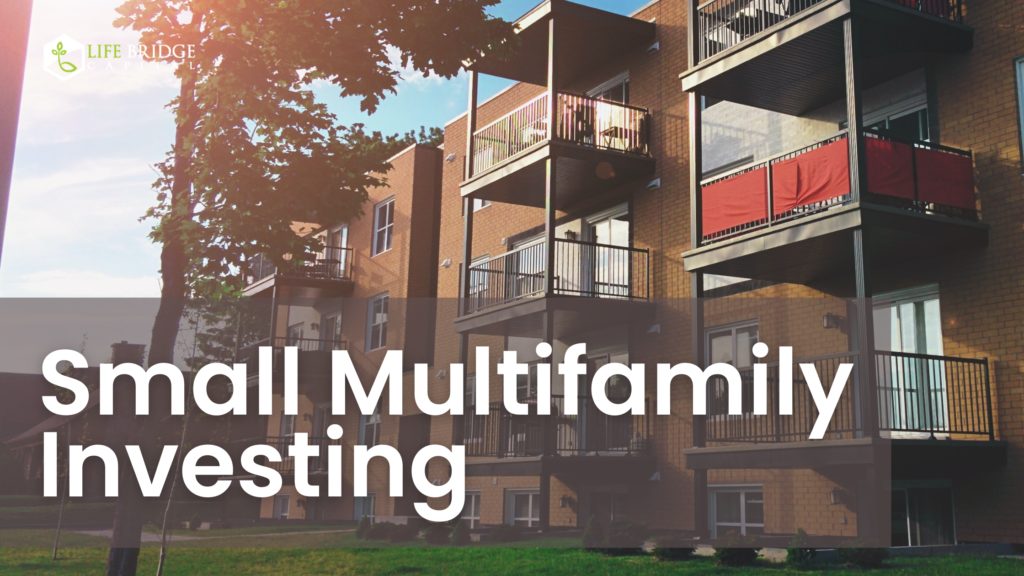
When considering multifamily investing, high-rise buildings or vast suburban apartment complexes may come to mind. However, small multifamily properties offer an accessible point of entry for investors and fill an essential niche in many communities.
Life Bridge Capital is a leading real estate syndication company. We offer our investment partners the opportunity to leverage shares of multifamily rental properties into a passive monthly income. Learn More.
Benefits of Small Multifamily Property Investing
Small multifamily properties—which encompass properties with two to four units—create less income than those with five or more units. However, they still have an important place in the market, both for investors and residents. They offer many of the same advantages of multifamily investing, like reliable income and price appreciation, whilst being a valuable stepping stone towards a larger career in real estate investing.
1. More Affordable
The affordable entry point means less capital is required to operate and maintain these properties. And while the smaller purchase price may be obvious, a reduced budget for renovations is an added plus. When the lesser upfront cash requirements are coupled with a solid exit plan, small multifamily properties appeal to the most risk-averse of investors.
2. Easier to Maintain and Operate
Many investors find it possible to maintain and operate small multifamily properties without the assistance of a property management company. While we frequently discuss the challenges of being a landlord, owning and operating a small multifamily property in good repair is feasible, even for those with traditional full-time jobs.
3. Diversity Your Portfolio Through Multiple Properties
Because small multifamily properties require less capital, owning more than one is entirely possible for investors who want to expand their real estate empires. Besides increasing income, owners can diversify their portfolios by purchasing properties in different markets. Doing so reduces overall risk by establishing additional streams of income that remain in place even if the neighborhood of one property declines in popularity.
4. House Hack to Reduce Living Expenses
Finally, some multifamily property owners prefer to live in one of the units; known as house hacking. Besides eliminating an additional rent or mortgage expense for your own living needs, it facilitates a lot of the responsibilities that come with owning such a property.
In particular, owners who are DIYing any part of a renovation or taking care of repairs on their own find it convenient to live on site. And, even those who prefer to outsource maintenance-type work can benefit from being on-site to manage tenant issues.
Living on-site provides the added bonus of qualifying the property for an FHA loan, which we explain further below.
5. Pandemic Appeal
Small properties had appeal during the pandemic. They saw greater demand as residents preferred the extra freedom and safety provided, as they usually offer private entrances directly to the outdoors.
For building owners, few, if any, additional precautions need to be made to keep the property running during outbreaks; as the units are independently contained and rarely have administrative offices or staff on-site.
How to Finance Small Multifamily Properties
Small multifamily properties include duplexes, triplexes, and fourplexes. After finding a prospective property, expect the purchase process to look similar to buying a single-family residence. The main difference comes from the need to evaluate the income and price appreciation potential of the property.
Besides analyzing the economics of the property to determine whether it is a worthwhile investment, the lender will likely require income projections and other financial information to fund the loan.
If only a short-term loan is available to you, refinancing through a bank, taking on a partner, and even flipping the property for sale are just a few options to employ.
FHA Loans Require Minimal Down Payments
Finding the money for a down payment on a small multifamily property may seem like a huge barrier, but Federal Housing Administration (FHA) loans require as little as 3.5 percent down for borrowers with a credit score of more than 580.
To qualify for FHA loans, a property must be used as the borrower’s primary residence for at least one year, which makes house hacking a critical tool to qualify for these low-down payment loans.
From there, consider assuming a second private loan, taking on a partner, or using credit to cover the remainder of the purchase price.
Final Thoughts
For new investors, in particular, small multifamily properties are a fantastic opportunity to get experience with income-producing properties. And to build your cash reserves to expand your portfolio of properties.
Life Bridge Capital is a leading real estate syndication company. We offer our investment partners the opportunity to leverage shares of multifamily rental properties into a passive monthly income. Learn More.



